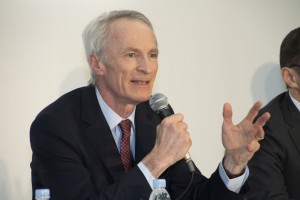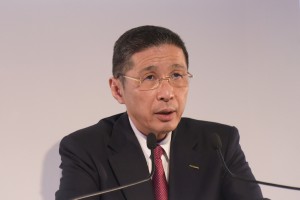The French government is weighing in on the proposed Fiat Chrysler-Renault merger plan and underscores the potential challenges the automotive merger faces before it can be completed.
Following four months of talks, FCA on Monday proposed a merger-of-equals with the larger of France’s two automakers, a plan expected to take up to 18 months to complete. Before that can happen, however, an assortment of obstacles will need to be overcome, among other things winning the blessings of the French government that holds a 15% stake in Renault.
French Finance Minister Bruno le Maire told RTL radio on Tuesday that he will demand “four guarantees” from Renault before approving any merger, starting with “the preservation of industrial jobs and sites in France.”
The FCA proposal did clear a minor hurdle when Renault’s board of directors said it will “examine.…with interest the opportunity of such a business combination.” But that was considered largely a formality as the two manufacturers have been in talks for about four months, according to well-placed sources.
(Click Here for our initial story on the FCA-Renault merger proposal.)

FCA CEO Mike Manley originally approached Renault over more limited plans, such as platform sharing.
The negotiations began early this year, about the same time things seemed to be going sour in separate discussions with the other French automaker, PSA Group, the parent of Peugeot and Citroen. Initially, FCA sought to discuss with Renault possible partnerships such as platform sharing but, as the discussions continued, the breadth of topics expanded to the point where a merger-of-equals was put on the table, according to an insider closely involved in the discussions.
That is, of course, the sort of arrangement that the Chrysler side of FCA is quite familiar with. In 1998, it merged with what then Daimler-Benz, but despite promises that the two would have an equal footing, it quickly became apparent that the German side of the company would dominate. But the corporate cultures never really meshed, and the promised synergies failed to materialize so DaimlerChrysler broke up a decade later, the American side being sold to financial giant Cerberus.
Ironically, as the American economy started to collapse and Cerberus recognized it couldn’t pull things off, it went looking for a new partner and began talking with Renault. The discussions collapsed because of the massive financial uncertainties surrounding the U.S. automaker’s captive finance unit. That issue subsequently was resolved when Chrysler went through a government-directed bankruptcy and Fiat, under Marchionne, stepped in as its white knight to ensure a bailout by the Obama Administration.

Renault Chairman Jean Dominique Senard has to maneuver a deal that won't shatter the long Alliance with Nissan.
“The tie-up between Chrysler and Renault made sense in 2008,” said Jim Press, who served as vice chairman and co-president of Chrysler LLC at that time. “It makes even more sense today given the market strength of FCA (in SUVs and pickups) and their similar cultures that would make them uniquely suited to work well together,” added Press, who now heads the RML Automotive dealer network.
In particular, the U.S. automaker is one of the world’s dominant players in large pickups and SUVs. Its Jeep division alone will sell around 2 million vehicles this year, sales roughly quadrupling over the past decade.
For its part, Renault has a variety of passenger car lines that are missing from the portfolio at Fiat Chrysler which has shifted largely to light trucks in recent years. Equally important, the French company has invested heavily in electric and autonomous vehicle development, an area the Italian-American automaker is sorely deficient.
For Renault, a deal with FCA could provide a backstop should the 20-year-old Renault-Nissan-Mitsubishi Alliance come crashing down. That’s become a distinct possibility following the arrest, last November, of Carlos Ghosn on financial abuse allegations. Ghosn was first assigned by Renault to manage its $6 billion bailout of the Japanese automaker in 1998 and had eventually come to run both the Alliance and all three of its members.
But Nissan had clearly been resisting Ghosn’s push for a full merger in the months ahead of his arrest – something sources have asserted played a role in the handling of his case. Since then, French and Japanese executives have tried to paper over their problems, but a well-placed Alliance source told TheDetroitBureau.com that “it’s regressing fast” and very well could fall apart.
Were that to happen, it could pose major headaches for Renault. Together, the three Alliance members formed the second-largest automotive group in 2018, with global sales of 10.76 million vehicles, a shade behind Volkswagen AG’s 10.83 million. Alone, Renault would find itself a relatively modest industry player. Together with FCA, however, it would remain an industry leader. And, if FCA were to become the fourth leg of the Alliance, the group would handily surge past VW.
Whether the Alliance can survive is far from certain, though sources at Fiat Chrysler insist that they are hoping not to be the reason behind a break-up. Significantly, of the 5 billion euros – about $5.6 billon – in synergies the deal proposes, Nissan and Mitsubishi are promised about 20 percent.
Asked for comment on the FCA-Renault merger proposal, Nissan responded with a terse statement saying it “has no comment at this time. We will closely monitor the discussions.”
(Nissan earnings tumble; Ghosn scandal a factor. Click Here for the story.)
There are plenty of other potential challenges to a Renault-FCA merger. Other government entities, including U.S. and European Union regulators, would likely have to rule out anti-trust concerns, for one thing.
And unions in the U.S., France, Italy and other parts of the world could also complicate the process were they to decide to set up roadblocks.
Should it all come together, a source close to the negotiations said, the proposed merger would take at least 12, and possibly 18 months to pull into place.
At that point, based on 2018 sales, the two manufacturers would become the fourth-largest player in North America, number two in Europe, Africa and the Middle East and the king-of-the-hill in Latin America. Then there is the Asia Pacific region, where they have lagged and hope that by joining forces they can make significant headway.
While there would still be some serious problem spots, such as China, where FCA and Renault individually lag far behind leaders like Volkswagen and General Motors, they’d have some new-found momentum adding to the fact that the group’s global sales – assuming the Renault-Nissan-Mitsubishi Alliance survived – would handily top 15 million, giving it a massive lead over its nearest competitors.
(Nissan shoots down Renault merger proposal. Click Here for the story.)


this is going to be a big hairy mess if it goes forward. Culturally, product overlap-wise, personalities, government involvement…
And they say soap opera is dying.
I believe Nissan would stay as long as the monies continued to flow in but they have already shown they want to control their own destiny…albeit with other people’s money.
So American it may work…;)
But in all seriousness I don’t believe the four-fecta will provide all the good some think it will. Too much like “Merger of Equals” speak.